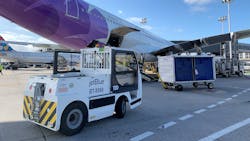TLD to Phase Out Mechanical Drivelines by 2024
Officials at TLD identified three main challenges currently facing the ground support industry – the need for sustainability; growing and developing the skills and competencies of the workforce with new technologies; and a constant cost challenge in a competitive world.
To simultaneously address these challenges, TLD is introducing its Alternative Power Source solution to customers and announcing its objective to stop mechanical drivelines by the end of 2024.
According to Valentin Schmitt, CEO of TLD Group, the major hurdle on electrification today, which is shared by the company’s entire customer base, is the gap with infrastructure. This includes the position of and type of chargers, as well as the number of chargers or charging slots
“The differentiation of our Alternative Power Source strategy is to propose our customers standardize around electric GSE, but with various types of power sources – batteries, hybrid systems with on-board generators, hydrogen fuel cells, or on-board chargers compatible with 400 Hz,” Schmitt says, adding with different, interchangeable building blocks individual customers can define the electric GSE that will fit with current infrastructure and continue to evolve as the infrastructure grows.
Moving forward, Schmitt says all mobile GSE from TLD will come with a “future ready” electric driveline. The Alternative Power Sources of these drivelines include fully electric options with TLD’s iBS lithium-ion batteries; hybrid versions with its iHS or ipHS hybrid packs; and hydrogen.
“This is a major push towards sustainable aviation, with a set of technical solutions allowing to decouple the electrification of the GSE, expected by all players, from the infrastructure, which might take longer to adapt and will propose different alternatives depending on the regions,” Schmitt says.
By decoupling the electrification of the GSE from the infrastructure, TLD officials say ground handlers can embark on sustainability goals immediately and use the natural renewal of a fleet to grow the electrification ratio.
This will allow customers to avoid facing a “CapEx wall” in 5 or 10 years with a large part of the fleet to be renewed in a short period, Schmitt says.
“The standardization of the solution around a few components that will be available for all GSE – TLD and non-TLD, by the way – will simplify the maintenance training and improve the adaptation of the teams’ skills to those evolving technologies,” he says.
A key challenge for TLD was developing a one-size-fits-all solution, with a battery or hybrid pack being common for almost all GSE.
“This is not only bringing simpler maintenance, a lower inventory for parts, or simpler training. It is allowing (customers) to swap those systems from one application to another, aging the batteries over several lives in those different applications. This will drive the TCO even lower,” Schmitt says.
Electric and hybrid solutions are now available on more product lines and should be available on almost everything by the end of 2022, according to Schmitt.
“We believe that every customer today has, at a different level, a sustainability agenda. And for those who don’t, I am sure they are actively working on it to avoid losing ground against the competition,” he says. “There is a lot to learn, but this is also lowering the cost base and creating competitiveness for the future.”
About the Author
Josh Smith
Editor
Josh Smith served as editor of Ground Support Worldwide as editor from 2016 through 2024. He oversaw production of the print magazine, created GSW's newsletters on a daily basis, and updated the latest news on AviationPros.com.

